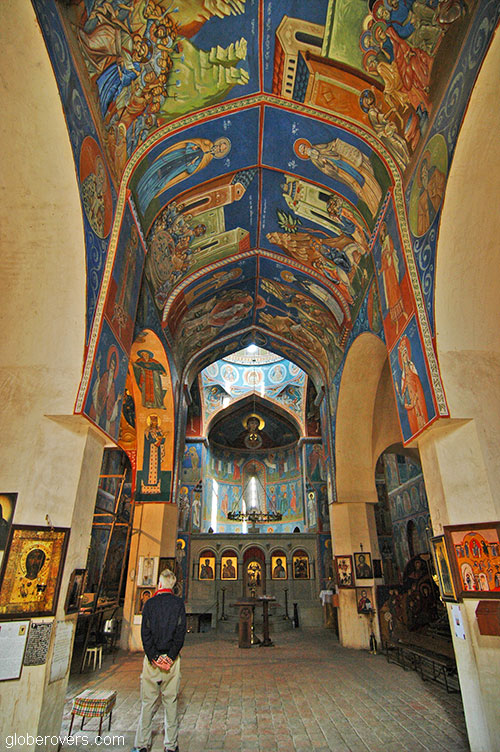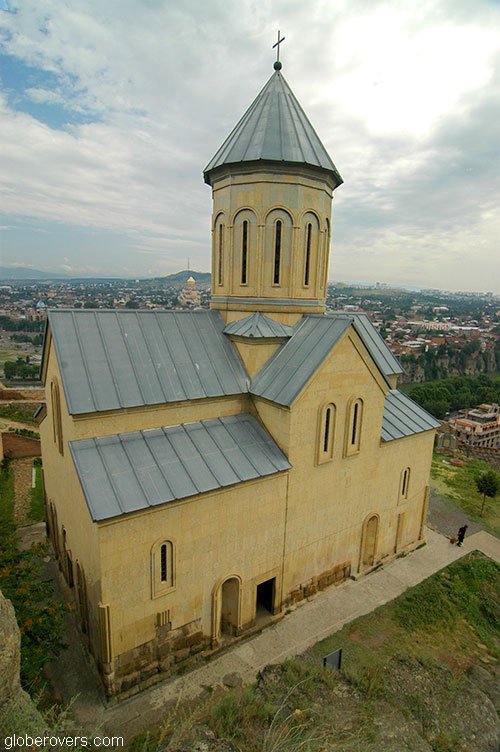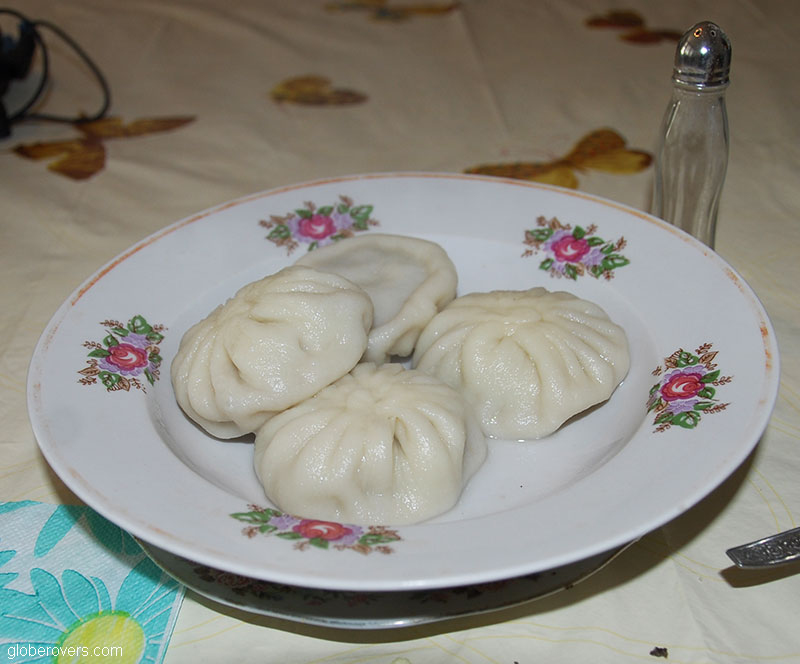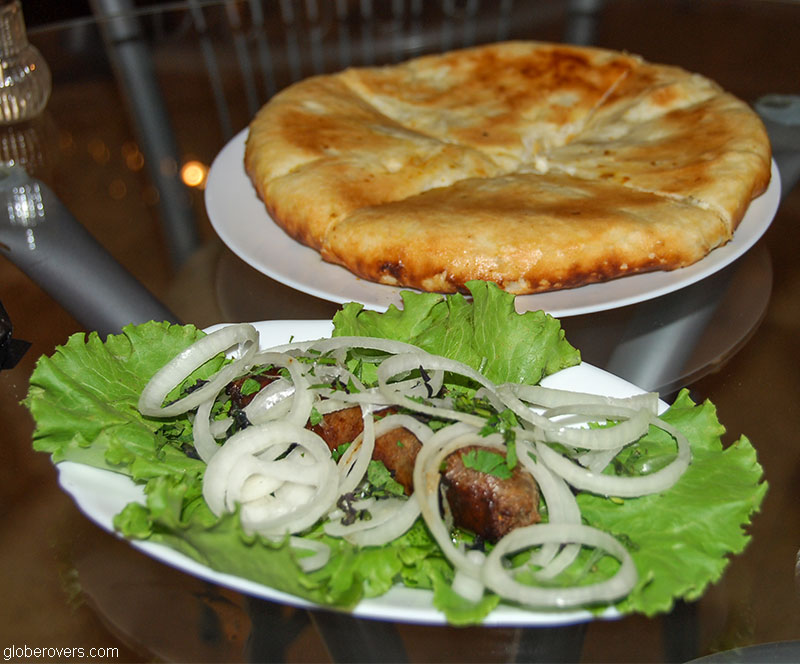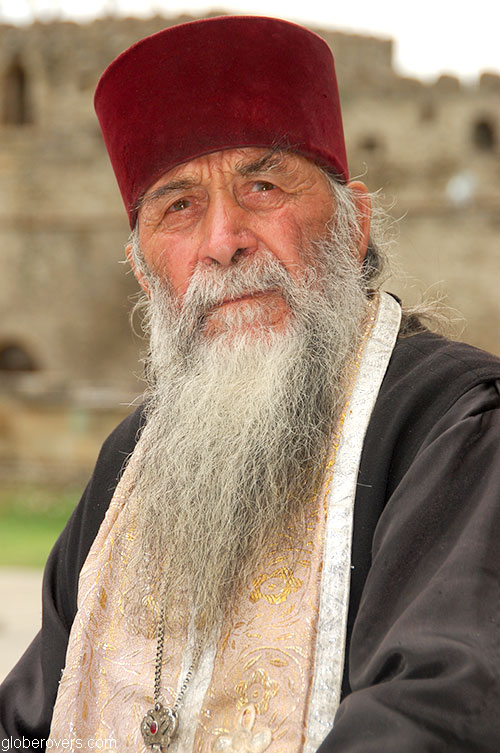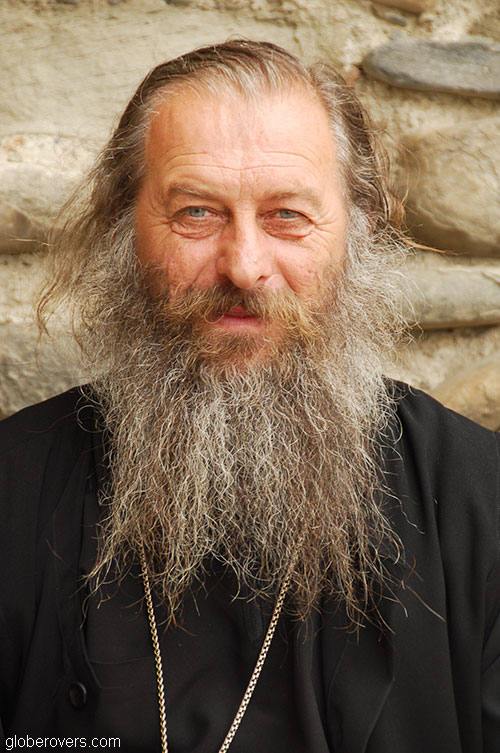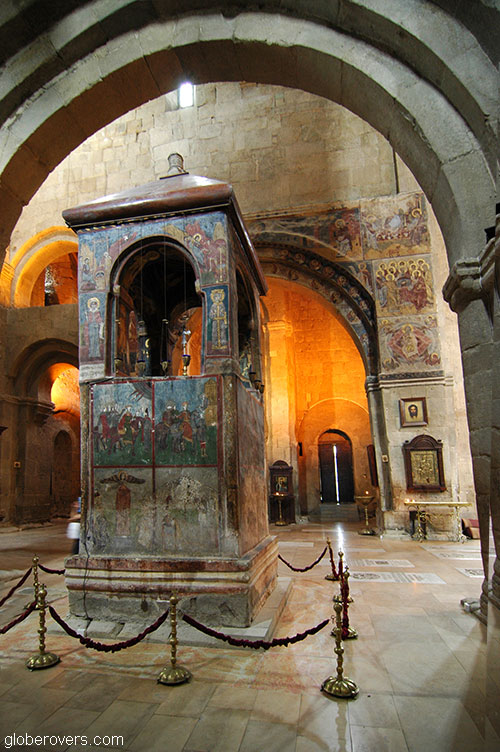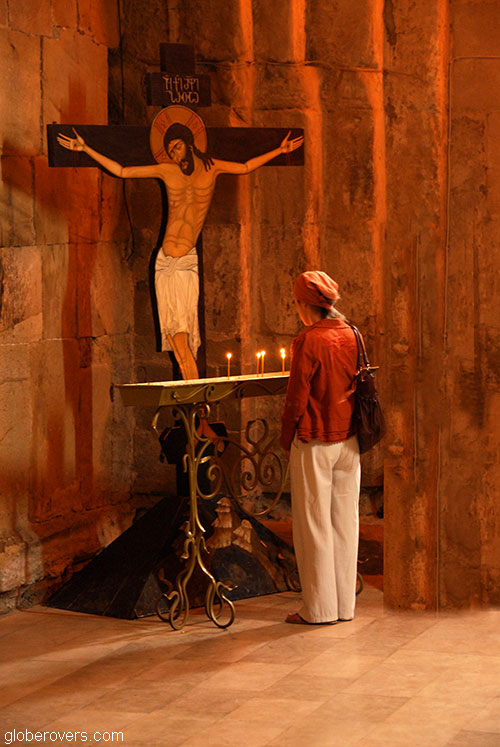
Caucasus, as a region, is not a familiar area to many people. The region is generally defined to include Armenia, Azerbaijan, Georgia, and nearby areas within Iran, Russia, and Turkey. It has a foothold in both Eastern Europe and Western Asia, but is generally viewed as part of Europe.
Blessed with some of the world’s most stunning landscapes, the Caucasus is home to Mount Elbrus (5,642 m), the highest mountain in Russia and in Europe, including the Caucasus region.
Georgia, the “land of dagger dancing”, is etched between northeastern Turkey and southwestern Russia, bordering Armenia and Azerbaijan to the south. It has a distinctive culture and a long and rich history that can be traced back to the classical era (7th BC to 5th BC) and beyond.
With a compelling blend of both European and Asian cultures and heritage, Georgia offers a mix of Euro-Asian architecture and culture, rivalled only by the natural beauty of its mountain landscapes.
Why Travel to Georgia?
- The low-down: Georgia is known for its friendly people, unique culture with colourful dances, food, old towns, mountains, and the many monasteries and old churches.
- The brightest highlight: Georgia has so many highlights. To choose one, it will have to be a trip north along the Military Highway to the imposing Tsminda Sameba Church near the villages of Gergeti and Kazbegi.
- Intrepid destination: Foreign travellers are quite scarce in Georgia, especially outside of the capital, Tbilisi.
- Globerovers score (10 is highest): Georgia is a gem waiting to be discovered. In many areas you will feel like a true explorer. I will score Georgia 8/10.
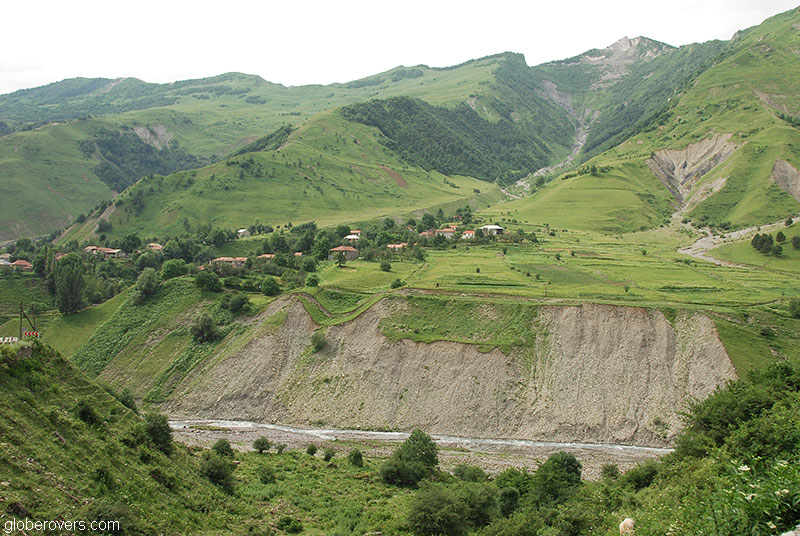
Table of Contents
Welcome to Georgia of the Caucasus
We start our journey in the capital city of Tbilisi. This sprawling city, located on the banks of the Kura River, has a population of about 1½ million people. You can easily spend several days here, and if you are into photography, you will find heaven in Tbilisi. The old city, called Altstadt, is a labyrinth of narrow streets where wooden balconies look down from old brick-built homes.
From Tbilisi, we head north along the infamous 210 km long Georgian Military Highway which runs between Tbilisi up north to Vladikavkaz, the capital of the Republic of North Ossetia–Alania, in Russia. This was the traditional route used by both invaders and traders throughout the early ages.
When you look on the map you will understand why the Caucasus is described as “Where East meets West”. Georgia is right in the centre!
Shortly before the Russian border, on the south side of the mighty Caucasus Mountains, lies the Kazbegi National Park and the village of Kazbegi. At an altitude of 2,170 m, high above Kazbegi, and with Mouth Kazbek rising behind it, you will see the 14th-century church of Tsminda Sameba. Also known as the Gergeti Trinity Church, this is a photo opportunity not to be missed! Hike up to the church for stunning views!

Tbilisi, the Capital
Founded in the 5th century AD, Tbilisi has a history rich in romances with the early Kingdom of Iberia, the Russian Empire, the Imperial Viceroy, and of course, many friends and foes passing through its doors on the lucrative east-west trade routes.
Walk around the old city of Tbilisi (Altstadt) and see evidence of its very diverse history. Notice the mix of Medieval, Classical, Middle Eastern, Art Nouveau, Stalinist and even Modernist structures.
The old city of Tbilisi is reminiscent of a movie set, complete with old brick-built homes sporting colourful doorways and wooden balconies.
The Altstadt, at the heart of the city, has an eclectic mix of modern and rather ancient buildings. Set against the looming 4th-century Narikala Fortress, which was destroyed in the 13th century and rebuilt in the 7th and 17th centuries, the old city is a labyrinth of narrow streets. Colourful, arched wooden balconies, protruding from old brick-built homes, look down on the action below.
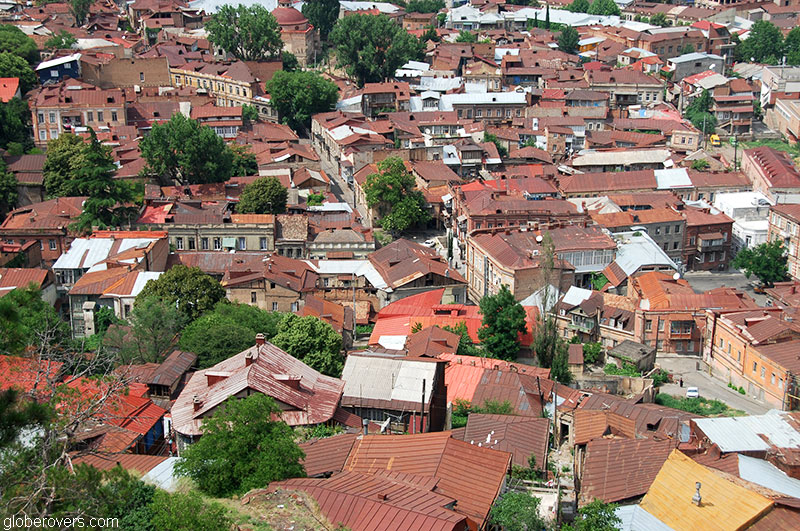
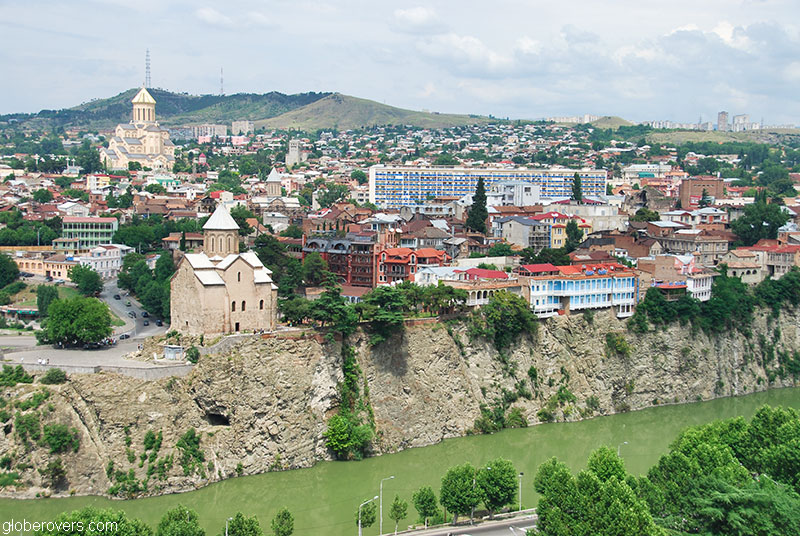
Tbilisi is Built Around Hot Springs
The city’s sulphur baths in Abanotubani, in the midst of the old town, are still in operation and are famed to be the source of the city’s existence. Legend has it that visiting traders on their visit to the city along the spice route were ordered to bath in one of the many baths before they could enter the city. During the time of the legendary Roman bathers who settled here, the city had many baths of which only a few are left now. Where you see brick domes rising out of the ground, you will know there is a thermal bath beneath. Go in and soak in the sulphurous springs.
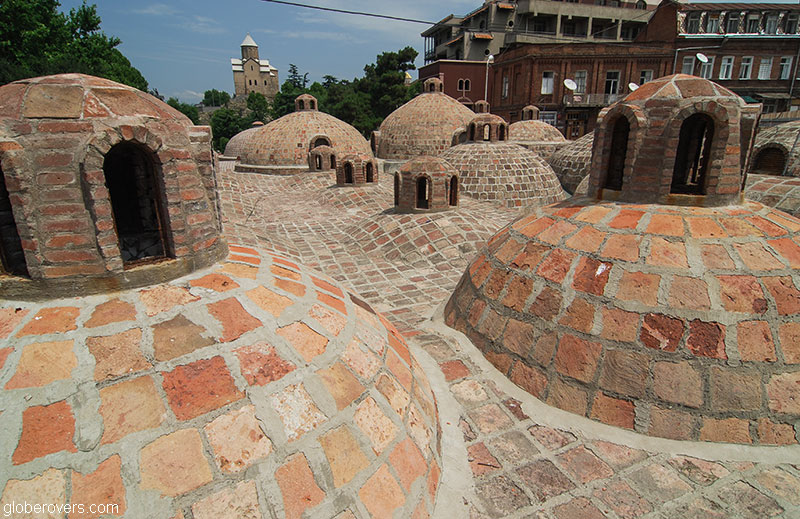
Tbilisi Attractions
Built on the banks of the Kura River, the city seems to sprawl over the edges of the river. A good start to exploring the city would be the Narikala Fortress which somewhat dominates the skyline. Dating back to the 4th century when it was a Persian Citadel, the fortress has a more colourful history than its dilapidated condition can offer today.
Tbilisi also offers the 13th-century Metekhi Church, the Kashveti Church, Sioni Cathedral, and the city’s oldest surviving Anchiskhati Basilica. The city is home to several museums and galleries, fortresses, palaces, parks, and a lovely botanical garden.
Take a ride up Mt. Mtatsminda on the funicular for spectacular views. Another of Tbilisi’s exhilarating rides is the cable car which swings over the Mtkvari River and the old town on its way up to the Narikala Fortress.
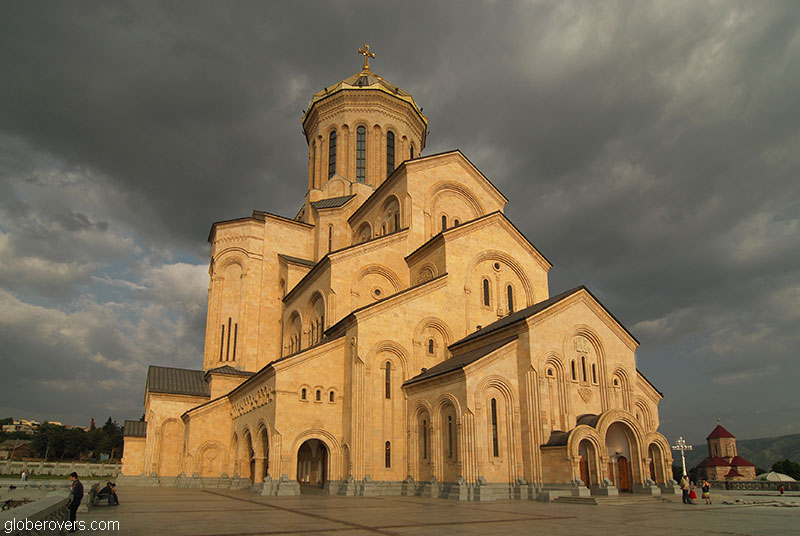
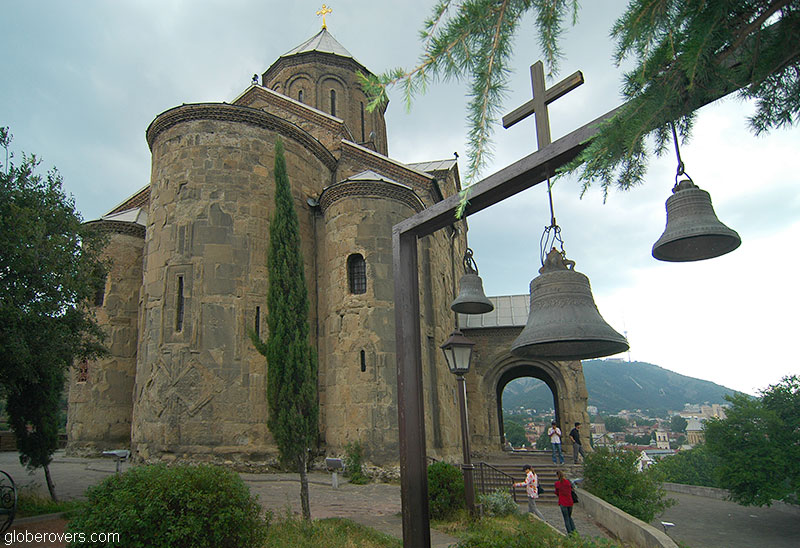


Kvemo (Zemo) Betlemi Church, Tbilisi 
Church of St. Nicholas, Tbilisi
Georgian Culinary Delights
When you look at the popularity of traditional Georgian restaurants in Tbilisi among foreigners, you will realise that many travellers come here with food on their mind.
When we talk Georgian cuisine, we talk “khachapuri” – Cheese-oozing khachapuri, which is gooey cheese-stuffed pizza bread that drips with heart-stopping goodness. Some are plain cheese, while others are egg-topped (adjarian khachapuri).
Don’t miss the khinkali, a dumpling made of twisted knobs of dough, stuffed with meat and spices. The most popular filling is a pork and beef mix. In the mountains, lamb filling is preferred.
Love meat? Then go for the mtsvadi, fire-roasted chunks of pork, mutton or veal. Elsewhere it is known as shashlik and skewers. The qababi (kebabs) are made of minced meat, grilled, and sprinkled with sumac and onion slices. Simply delicious!
Mtskheta
Twenty-six kilometres north of Tbilisi, at the confluence of the Mtkvari (Kura) and Aragvi Rivers, lies the town of Mtskheta. Its historical buildings are of extraordinary importance in Georgian culture as it has been Georgia’s spiritual heart since Christianity was established here in the 4th century. Mtskheta was the capital of the eastern Georgian Kingdom of Iberia from the 3rd century BC, and remained so until the 5th century AD when the capital moved to Tbilisi.
Take a marshrutka (minibus) from Tbilisi and walk around this interesting town with the Sveti-Tskhoveli Cathedral at its heart. Take a pleasant 5 km stroll up the hill to the Jvari Monastery.
Sveti-Tskhoveli Cathedral
Rebuilt during the 11th century, the current cathedral is home to important ceremonies within the Georgian Orthodox Church. Starting in the 4th century, the church and its original buildings have a rich history, filled with invasions and destructions by the Arabs, Persians, and Russians. Even earthquakes could not totally destroy the building.
Declared a UNESCO World Heritage Site, the cathedral is a masterpiece. Set aside enough time to explore it. Ten of the Georgian kings who were coronated here, are also buried in front of the altar.
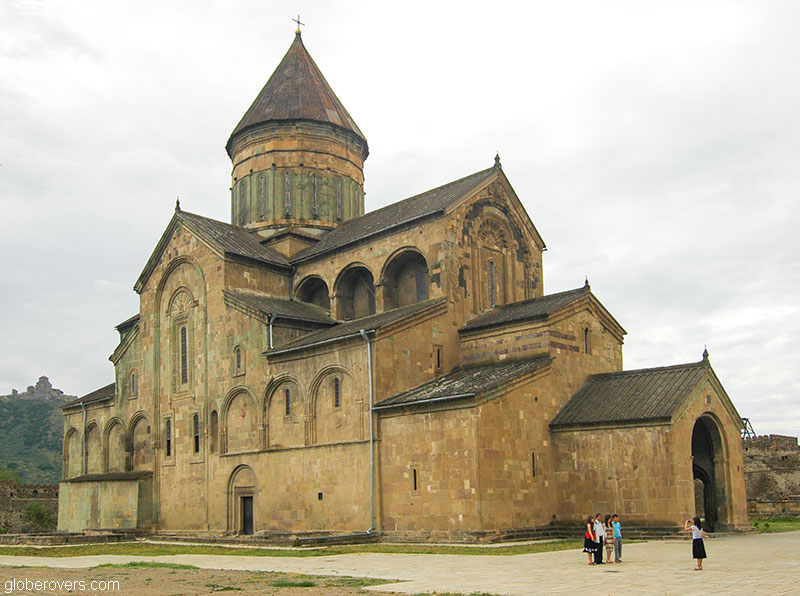
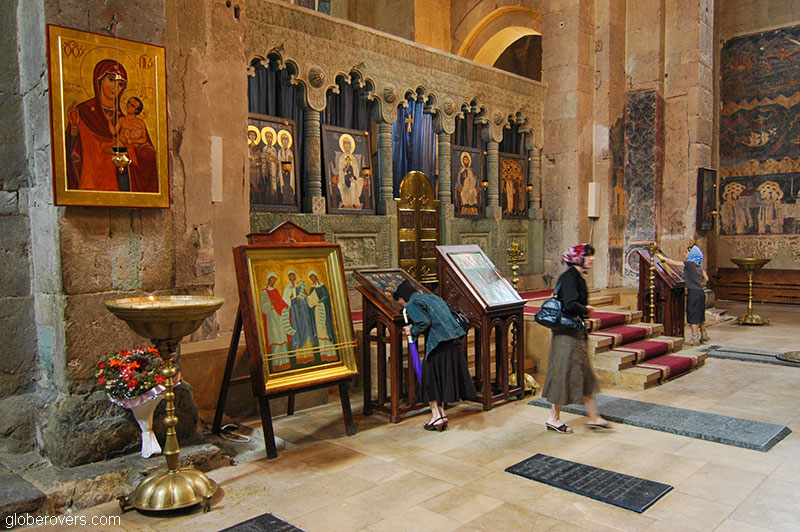

Monk at Sveti-Tskhoveli Cathedral, Mtskheta 
Monk at Sveti-Tskhoveli Cathedral, Mtskheta

Sveti-Tskhoveli Cathedral, Mtskheta 
Sveti-Tskhoveli Cathedral, Mtskheta
Jvari Monastery
This 6th-century monastery stands on the site where an early 4th-century wooden cross was erected on a rocky mountaintop overlooking Mtskehta. Recently it was added to the UNESCO List of World Heritage in Danger, due to its deterioration from the natural elements as well as inadequate maintenance, etc. The views from the monastery are spectacular.
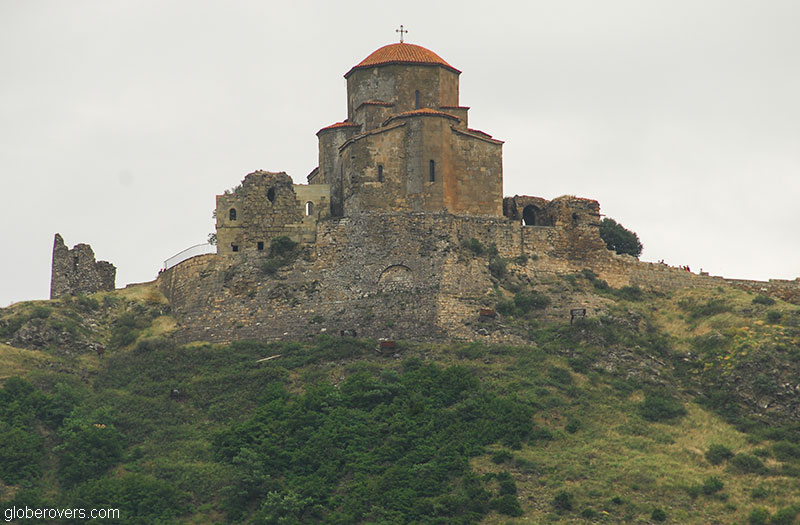
The Georgian Military Highway to Russia
With the Tsminda Sameba Church near Kazbegi on your agenda, head up north from Tbilisi along the famous Georgian Military Highway.
The road currently links Tbilisi and Vladikavkaz, the capital of the Republic of North Ossetia–Alania, in southern Russia.
First used by the Russian military in 1769, the road has been upgraded over the centuries and stayed mostly under Russian control.
This is the traditional route used by both traders and invaders throughout the ages.
While the road was paramount in the economic development of the Caucasus region in the 19th century, its importance has significantly diminished during the late 20th century. In 2006 Russia closed the border for seven years and eventually reopened it on specific demand from Armenia. The border crossing remains open, but long border delays can be expected due to the time required to process and inspect vehicles, mainly on the Russian side.

The road on the Georgian side is not short of spectacular scenery. Rolling hills and snow-covered peaks decorate the scenery for most of the way. The road passes by the 13th-century Ananuri Castle on the shores of the turquoise Zhinvali Reservoir. Further north lies the Gudauri ski resort in the Gudauri Recreational Area. At about 125 km north of Tbilisi, on the right-hand side of the road, is the Russia–Georgia Friendship Monument constructed in 1983 to celebrate the bicentennial of the Treaty of Georgievsk and ongoing friendship between Georgia and the then Soviet Russia. The inside paintings depict scenes from Georgian and Russian history.
Along the road are a few abandoned buildings, including monasteries.

The road follows the flow of the Aragvi River, all the way to the Kazbegi National Park on the slopes of the Caucasus Mountain Range which forms the Russia-Georgia border. The villages of Kazbegi and Gergeti are just 10 km south of the border. This is why you came here. To see the beautiful Gergeti Trinity Church (Tsminda Sameba) perched on a hill surrounded by the mountains.
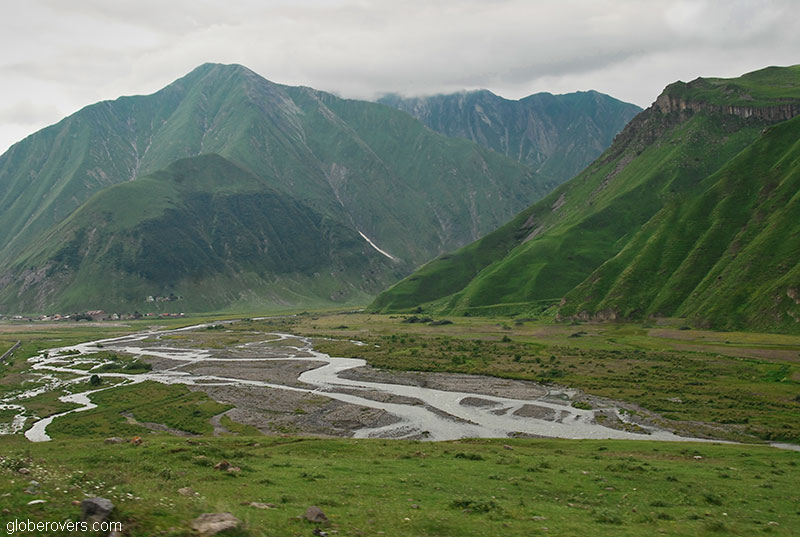

Kazbegi
Just 10 km south of the Russia-Georgia border in the shadows of Mount Kazbek (5,047 m) in the Caucasus Mountain Range, are the villages of Kazbegi and Gergeti.
Kazbegi, also known as Stepantsminda, is right next to the Georgian Military Highway. The village is a great base for hiking around the area. Several guesthouses and homestays are available for those who want to hang around in this beautiful and tranquil area. If you want to splurge, stay at the Rooms Hotel Kazbegi, where the cheapest room is about US$200.
The villages of Kazbegi and Gergeti are photogenic, though the gem of the valley is the Gergeti Trinity Church in the shadow of Mount Kazbek
The rustic village of Gergeti lies a short walk to the west of Kazbegi. From the village, it takes about eight hours to and from the lower tongue of the 7 km long Gergeti glacier on the southeastern slope of Mt. Kazbek. The path goes 1,600 m up to the glacier, and then back down.

While both villages are interesting to explore and photograph, the reason why most travellers come here is to photograph the 14th-century Gergeti Trinity Church. Though the church is beautiful, what is most special is its stunning location, being surrounded by green hills and the towering Mt. Kazbek in the background. In winter, the area is covered in snow, while during spring and summer it’s covered in green grass and yellow flowers.
Situated on the high banks of the Chkheri River, at an elevation of 2,170 m, it is a tough hike up from the village to the church. A small road goes the long way up to reach the church, but it’s a lot more adventurous to hike along the footpath.
The small bell tower stands separate from the church and was built around the same time.
After years of closure during Soviet rule, the church is now open for worshipping as part of the Georgian Orthodox and Apostolic Church.
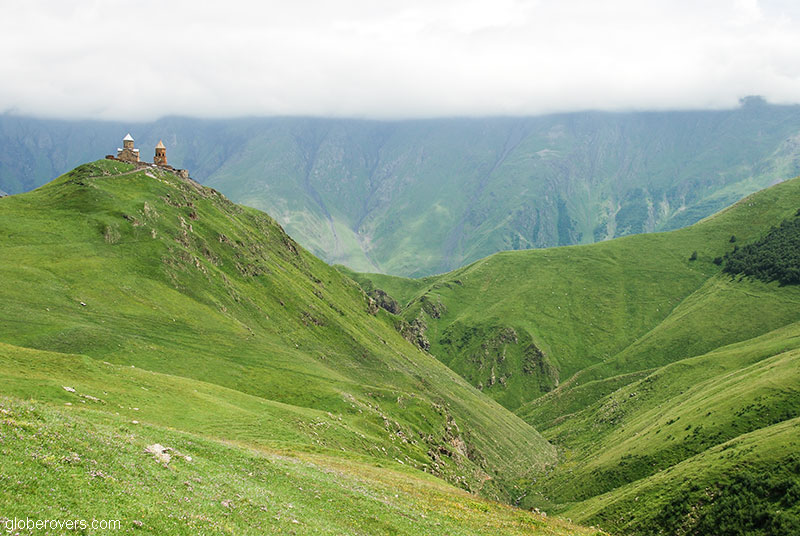
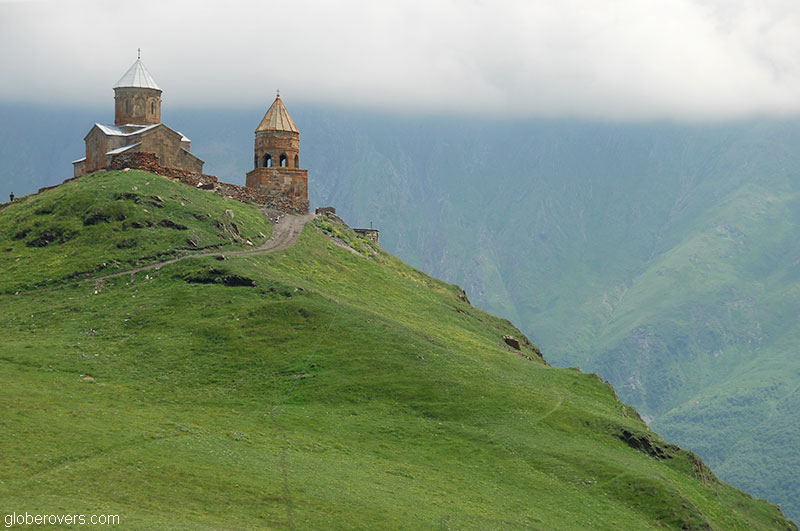
Essential Information
Getting There
The easiest way to Tbilisi is by plane. Several airlines fly into the Tbilisi International Airport. Some more exciting journeys to the capital include the train from Yerevan (Armenia) or from Baku in Azerbaijan. Buses, minibuses and grand taxis (marshrutkas) ply the roads between Tbilisi and Azerbaijan, Armenia, and Turkey. Boats sail to Romania and Ukraine
Getting Around
The Tbilisi Metro opened in 1966 and, in typical Soviet fashion, the rather derelict stations are very deep and vividly decorated. It has limited coverage but is efficient. Most people rely on the yellow city buses and ample marshrutkas to provide an above-ground complement to the metro. Outside Tbilisi, travel by train, bus, marshrutka, or by car.
Photography
Tbilisi can keep a photographer busy for life! The city is old (established in about 479 AD) with many buildings in a derelict state which have great character. The old part of the city is a photographer’s delight. People generally don’t mind being photographed. Old churches, monasteries, villages, and beautiful mountain landscapes are all great subjects.
When to Go
Located between the Black Sea and the Caucasus Mountains, Georgia can be visited at any time of the year. There is no real peak season or off-peak season. Summers are hot and humid, while winters are mildly cold with snow on the northern mountains. Every season warrants a visit.
Where to Stay
Tbilisi offers a range of hostels, guesthouses, hotels, apartments and homestays. Guesthouses or homestays are a great way to get to know the local way of life. An apartment rental will also allow you to try your own version of local cooking. Rural areas offer mostly homestays.
Safety
Some governments advise against all travel to the breakaway regions of South Ossetia and Abkhazia bordering Georgia. Also, note that firearms are readily available in Georgia. Take the usual precautions and be streetwise. Many travellers have explored Georgia without any hassles.
Dining Out
Georgia is known for its cuisine! You certainly will come across the ever-popular khachapuri (cheese-filled bread like a pizza), khinkali (dumplings), and mtsvadi (shish kebab). Tbilisi has some great restaurants, but in the small villages, you need to rely on excellent home cooking.
Train Journeys
The Georgian Railway covers large parts of Georgia and has international links with Azerbaijan (Baku), Armenia (Yerevan), and a new connection with Turkey (Kars). Most trains are Soviet-made, slow, cheap but comfortable. Commuter trains (elektrichki) connect shorter destinations.
Cost of Travel
On the cost of living, Georgia ranks 470th out of 508 cities in the world which indicates that it is one of the cheapest countries. Travelling around the country is not expensive. Backpackers on a tight budget can get around on $20 a day. Hostel beds are as low as $3. Homestays are under $20.
☛ Read more: Tblisi to Kazbegi, Georgia

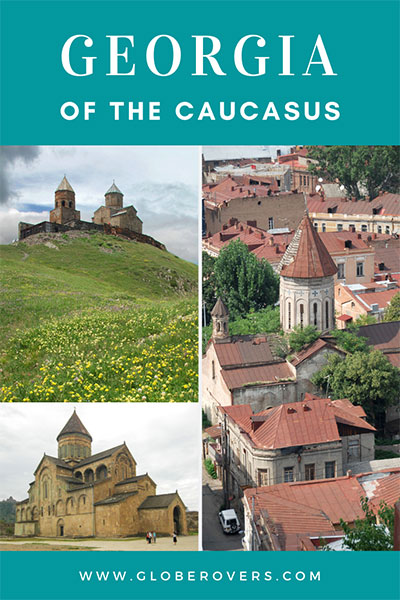

Blog post and photos by Peter who has been travelling almost full-time since 2005 and has been to over 122 countries. He visited several countries, such as Japan, more than 20 times. Peter is Editor-in-Chief and Publisher of GlobeRovers Magazine, an independent travel magazine focused on intrepid destinations.

